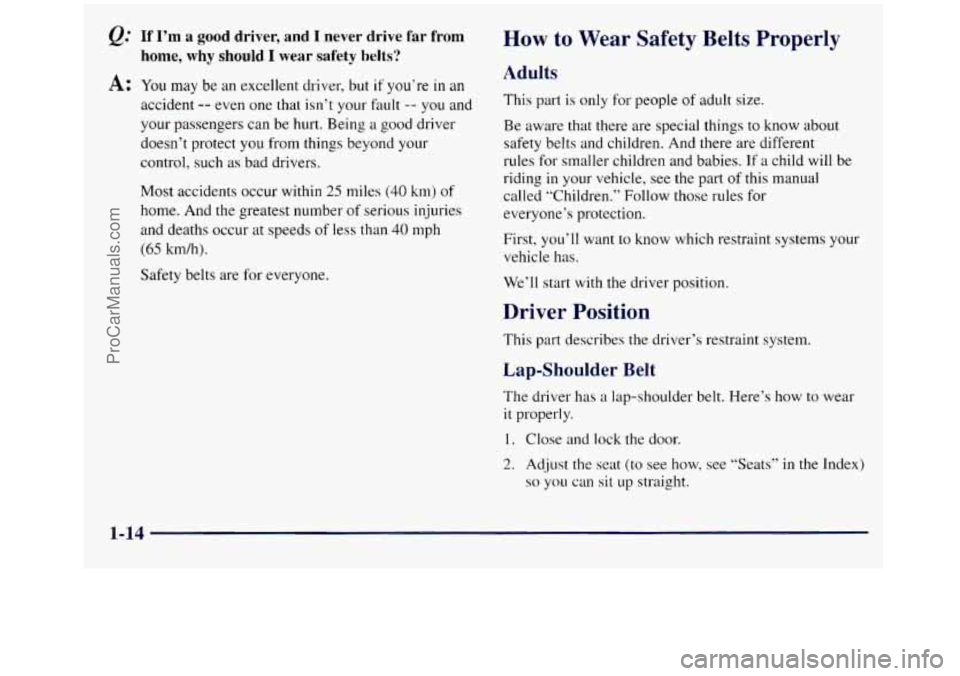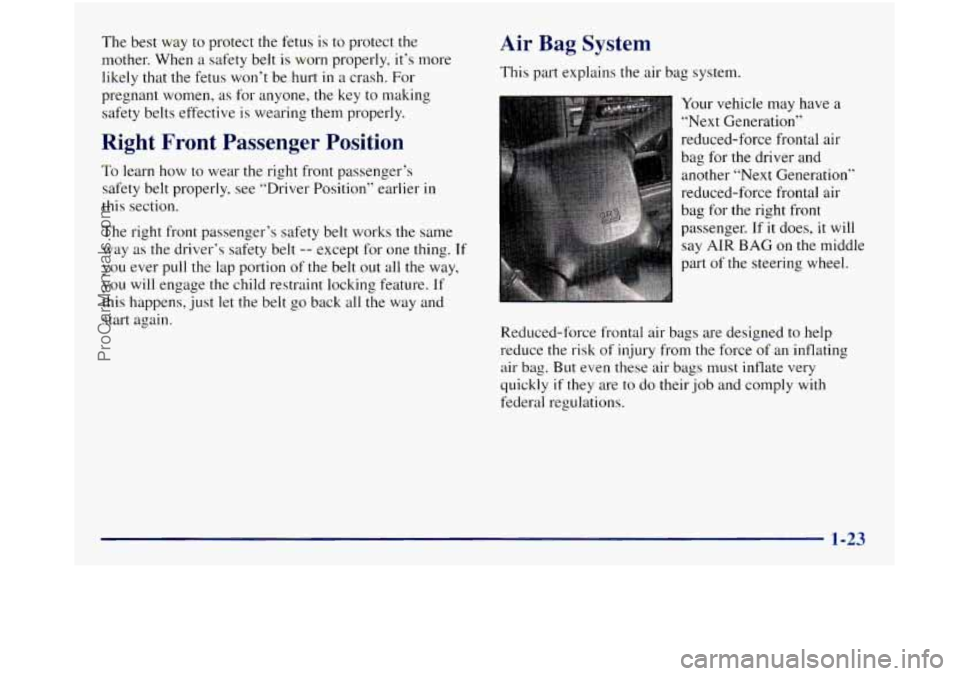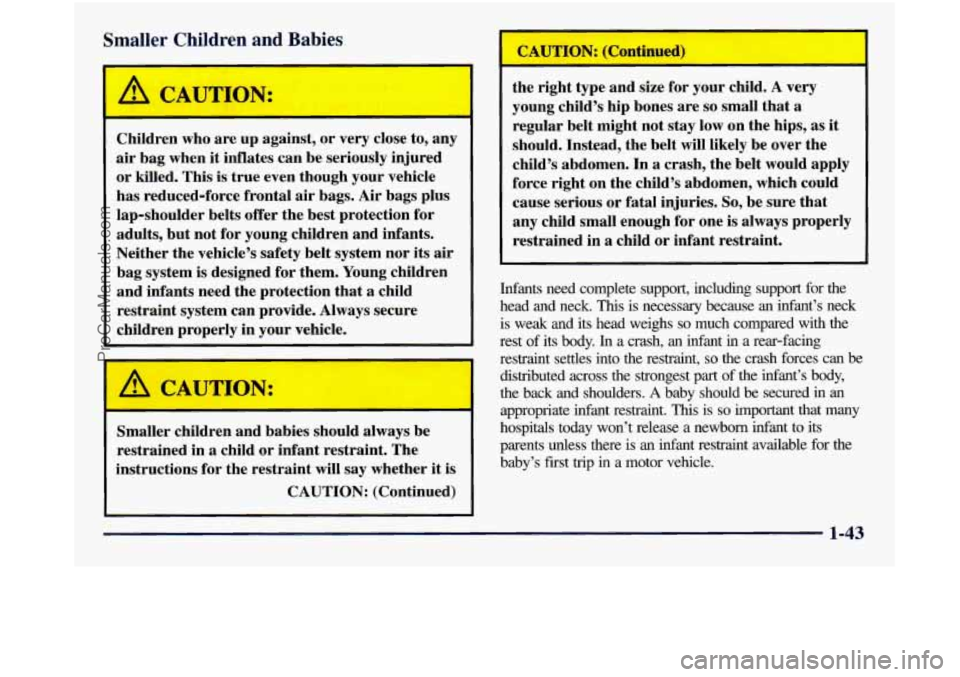Page 13 of 452
Section 1 Seats and Restraint Systems
Here you’ll find information about the seats in your vehicle and how to use your safety belts properly. You can also
learn about some things you should not do with air bags and safety belts.
1-2 1-9
1-13
1- 14
1- 14
1-22
1-23
1-23
1-32 Seats
and Seat Controls
Safety Belts: They’re for Everyone
Here Are Questions Many People
Ask About
Safety Belts
-- and the Answers
How to Wear Safety Belts Properly
Driver Position
Safety Belt Use During Pregnancy
Right Front Passenger Position
Air Bag System
Center Passenger Position 1-34
1-40
1-42
1-45
1-67
1-70
1-70
1-70 Rear
Seat Passengers
Rear Safety Belt Comfort Gu’ides for
Children and Small Adults
Children
Child Restraints
Larger Children Safety Belt Extender
Checking Your Restraint Systems
Replacing Restraint System Parts After
a Crash
ProCarManuals.com
Page 26 of 452

Q: If I’m a good driver, and I never drive far from
home, why should I wear safety belts?
A: You may be an excellent driver, but if you’re in an
accident -- even one that isn’t your fault -- you and
your passengers can be hurt. Being
a good driver
doesn’t protect you from things beyond your
control9 such
as bad drivers.
Most accidents occur within
25 miles (40 km) of
home. And the greatest number of serious injuries
and deaths occur at speeds
of less than 40 mph
(65 km/h).
Safety belts are for everyone.
How to Wear Safety Belts Properly
Adults
This part is only for people of adult size.
Be aware that there are special things to know about
safety belts and children. And there are different
rules for smaller children and babies.
If a child will be
riding
in your vehicle, see the part of this manual
called “Children.” Follow those rules for
everyone’s protection.
First, you’ll want to know which restraint systems your
vehicle has.
We’ll start
with the driver position.
Driver Position
This part describes the driver’s restraint system.
Lap-Shoulder Belt
The driver has a lap-shoulder belt. Here‘s how to wear
it properly.
1. Close and lock the door.
2. Adjust the seat (to see how, see “Seats” in the Index)
so you can sit up straight.
1-14
ProCarManuals.com
Page 35 of 452

The best way to protect the fetus is to protect the
mother. When
a safety belt is worn properly, it’s more
likely that the fetus
won’t be hurt in a crash. For
pregnant women,
as for anyone, the key to making
safety belts effective
is wearing them properly.
Right Front Passenger Position
To learn how to wear the right front passenger’s
safety belt properly, see “Driver Position” earlier in
this section.
The right front passenger’s safety belt works the same
way as the driver’s safety belt
-- except for one thing. If
you ever pull the lap portion of the belt out all the way,
you will engage
the child restraint locking feature. If
this happens, just let the belt go back all the way and
start again.
Air Bag System
This part explains the air bag system.
Your vehicle may have a
“Next Generation’‘
reduced-force frontal air
bag for the driver and
another “Next Generation”
reduced-force frontal air
bag for the right front
passenger. If
it does, it will
say AIR BAG
on the middle
part
of the steering wheel.
Reduced-force frontal air
bags are designed to help
reduce the risk of injury from the force of
an inflating
air bag. But even these air bags must inflate very
quickly
if they are to do their job and comply with
federal regulations.
1-23
ProCarManuals.com
Page 37 of 452
1
l Children who are up against, or very close to, an
air bag when it inflates can be seriously injured
or killed. This
is true even though your vehicle
has reduced-force frontal air bags. Air bags plus lap-shoulder belts offer the best protection for
1 adults, but not for young children and infants.
Neither the vehicle’s safety belt system nor its air
bag system is designed for them. Young children
and infants need the protection that
a child
restraint system can provide. Always secure
children properly in your vehicle.
To read how,
see the part of this manual called “Children” and
see the caution labels on the sunvisors and the
right front passenger’s safety belt.
~
AIR
BAG
There is an air bag
readiness light
on the
instrument panel,
which
shows AIR BAG.
The system checks the air bag electrical system for
malfunctions. The light tells you if there is an electrical
problem. See “Air Bag Readiness Light”
in the Index
for more information.
1-25
ProCarManuals.com
Page 41 of 452

0 Your vehicle is equipped with a crash sensing and
diagnostic module, whch records information about
the air
bag system. The module records information
about the readiness
of the system, when the sensors are
activated
and driver’s safety belt usage at deployment.
switch
on the instrument. panel that you can use to
turn
off the passenger’s air bag. But use this switch
only when you want to secure a rear-facing child
restraint at the right front passenger’s position. See
“Securing a Child Restraint
in the Right Front Seat
Position”
in the Index for more on this, including
important safety information.
0 Unless you have a Crew Cab, your vehicle has a
A CAUT-ON:
If the right front passenger’s air bag is turned
off, the person sitting there won’t have the extra
protection
of an air bag. In a crash, the air bag
wouldn’t be able to inflate and help protect the
person sitting there. Make sure the
air bag is
turned on unless
you are using a rear-facing child
restraint in the right front seat position.
0 Let only qualified technicians work on your air bag
system. Improper service can mean that your air bag
system won’t work properly. See your dealer
for service.
1-29
ProCarManuals.com
Page 52 of 452
To unlatch the belt, just push the button on the buckle.
Rear Safety Belt Comfort Guides for
Children and Small Adults
If your vehicle has a rear seat, your vehicle may have
shoulder belt comfort guides. This feature will provide
added safety belt comfort for children who have
outgrown child restraints and for small adults. When
installed on a shoulder belt, the comfort guide pulls the
belt away from the neck and head. There is one guide for each outside passenger position
in
the rear seat. To provide added safety belt comfort for
children who have outgrown child restraints and for
smaller adults, the comfort guides may be installed on
the shoulder belts. Here’s how
to install a comfort guide
and use the safety belt:
1. Remove the guide from its storage clip on the side of
the seatback.
1-40
ProCarManuals.com
Page 54 of 452
I
4. Buckle, position and release the safety belt as
described in “Rear Seat Outside Passenger Positions
(Extended Cab)” or “Rear Seat Outside Passenger
Positions (Crew Cab)” earlier
in this section. Make
sure that the shoulder belt
crosses the shoulder.
To remove and store the comfort guides, squeeze the
belt edges together
so that you can take them out from
the guides. Slide the guide onto the storage clip.
Make sure
you remove the comfort guide from the belt
before
you fold a rear seat down or use an easy-entry
seat, if your vehicle has one.
Children
Everyone in a vehicle needs protection! That includes
infants and all children smaller than adult size. Neither
the distance traveled nor the age and
size of the traveler
changes the need, for everyone,
to use safety restraints.
In fact, the law
in every state in the United States and in
every Canadian province
says children up to some age
must be restrained while in a vehicle.
1-42
ProCarManuals.com
Page 55 of 452

Smaller Children and Babies
Children who are up against, or very close to, any
air bag when it inflates can be seriously injured
or killed. This is true even though your vehicle
has reduced-force frontal air bags.
Air bags plus
lap-shoulder belts offer the best protection for
adults, but not for young children and infants.
Neither the vehicle’s safety belt system nor its air
bag system is designed for them. Young children
and infants need the protection that a child
restraint system can provide.
Always secure
children properly in your vehicle. the
right type and size for your child.
A very
young child’s hip bones are
so small that a
regular belt might not stay low on the hips, as
should. Instead, the belt will likely be over the
it
child’s abdomen. In a crash, the belt would apply
force right on the child’s abdomen, which could
cause serious or fatal injuries.
So, be sure that
any child small enough for one is always properly
restrained in
a child or infant restraint.
Infants need complete support, including support for the
head and neck.
This is necessary because an infant’s neck
is weak and its head weighs
so much compared with the
rest of its body.
In a crash, an infant in a rear-facing
restraint settles into
the restraint, so the crash forces can be
distributed across the strongest part
of the infant’s body,
the back and shoulders.
A baby should be secured in an
appropriate infant restraint.
This is so important that many
hospitals today won’t release a newborn infant to its
parents unless there is an infant restraint available for the
baby’s first trip in a motor vehicle. I
Smaller children and babies should always be
restrained in a child or infant restraint. The
instructions for the restraint will say whether it is
CAUTION: (Continued)
1-43
ProCarManuals.com